Page 299 of 392
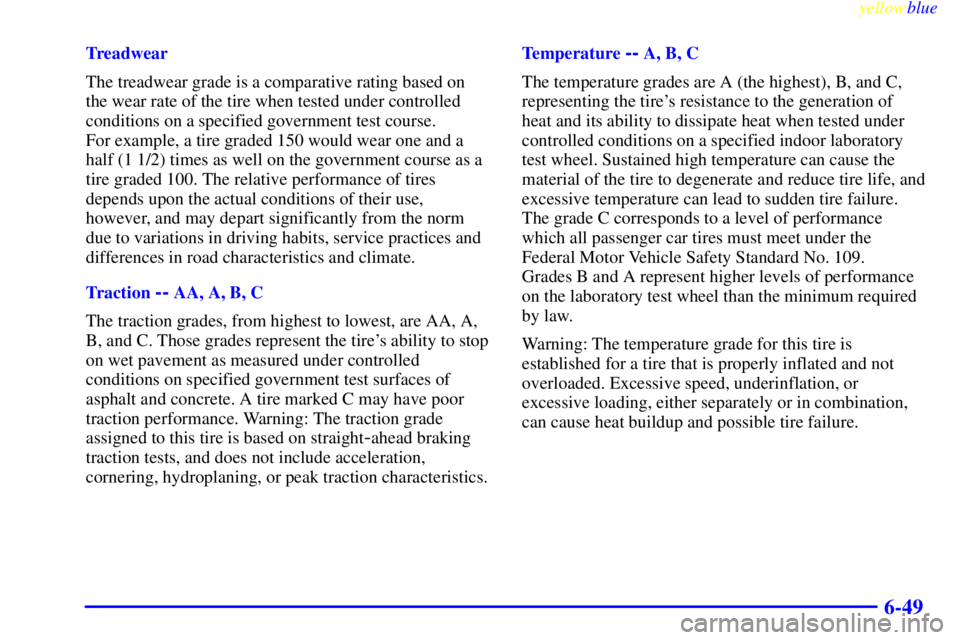
yellowblue
6-49
Treadwear
The treadwear grade is a comparative rating based on
the wear rate of the tire when tested under controlled
conditions on a specified government test course.
For example, a tire graded 150 would wear one and a
half (1 1/2) times as well on the government course as a
tire graded 100. The relative performance of tires
depends upon the actual conditions of their use,
however, and may depart significantly from the norm
due to variations in driving habits, service practices and
differences in road characteristics and climate.
Traction
-- AA, A, B, C
The traction grades, from highest to lowest, are AA, A,
B, and C. Those grades represent the tire's ability to stop
on wet pavement as measured under controlled
conditions on specified government test surfaces of
asphalt and concrete. A tire marked C may have poor
traction performance. Warning: The traction grade
assigned to this tire is based on straight
-ahead braking
traction tests, and does not include acceleration,
cornering, hydroplaning, or peak traction characteristics.Temperature
-- A, B, C
The temperature grades are A (the highest), B, and C,
representing the tire's resistance to the generation of
heat and its ability to dissipate heat when tested under
controlled conditions on a specified indoor laboratory
test wheel. Sustained high temperature can cause the
material of the tire to degenerate and reduce tire life, and
excessive temperature can lead to sudden tire failure.
The grade C corresponds to a level of performance
which all passenger car tires must meet under the
Federal Motor Vehicle Safety Standard No. 109.
Grades B and A represent higher levels of performance
on the laboratory test wheel than the minimum required
by law.
Warning: The temperature grade for this tire is
established for a tire that is properly inflated and not
overloaded. Excessive speed, underinflation, or
excessive loading, either separately or in combination,
can cause heat buildup and possible tire failure.
Page 300 of 392
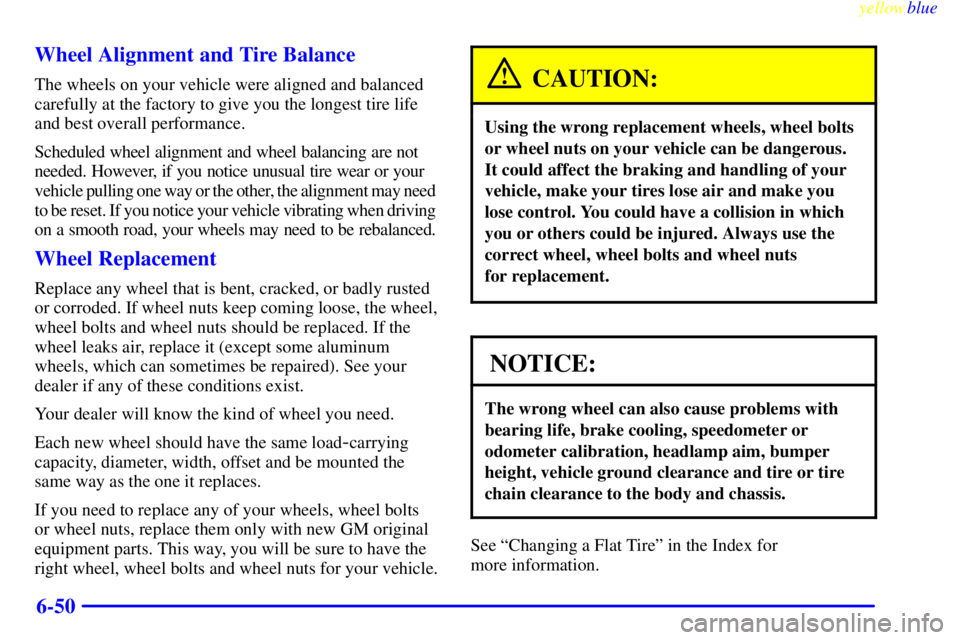
yellowblue
6-50 Wheel Alignment and Tire Balance
The wheels on your vehicle were aligned and balanced
carefully at the factory to give you the longest tire life
and best overall performance.
Scheduled wheel alignment and wheel balancing are not
needed. However, if you notice unusual tire wear or your
vehicle pulling one way or the other, the alignment may need
to be reset. If you notice your vehicle vibrating when driving
on a smooth road, your wheels may need to be rebalanced.
Wheel Replacement
Replace any wheel that is bent, cracked, or badly rusted
or corroded. If wheel nuts keep coming loose, the wheel,
wheel bolts and wheel nuts should be replaced. If the
wheel leaks air, replace it (except some aluminum
wheels, which can sometimes be repaired). See your
dealer if any of these conditions exist.
Your dealer will know the kind of wheel you need.
Each new wheel should have the same load
-carrying
capacity, diameter, width, offset and be mounted the
same way as the one it replaces.
If you need to replace any of your wheels, wheel bolts
or wheel nuts, replace them only with new GM original
equipment parts. This way, you will be sure to have the
right wheel, wheel bolts and wheel nuts for your vehicle.
CAUTION:
Using the wrong replacement wheels, wheel bolts
or wheel nuts on your vehicle can be dangerous.
It could affect the braking and handling of your
vehicle, make your tires lose air and make you
lose control. You could have a collision in which
you or others could be injured. Always use the
correct wheel, wheel bolts and wheel nuts
for replacement.
NOTICE:
The wrong wheel can also cause problems with
bearing life, brake cooling, speedometer or
odometer calibration, headlamp aim, bumper
height, vehicle ground clearance and tire or tire
chain clearance to the body and chassis.
See ªChanging a Flat Tireº in the Index for
more information.
Page 301 of 392
yellowblue
6-51
Used Replacement Wheels
CAUTION:
Putting a used wheel on your vehicle is
dangerous. You can't know how it's been used or
how far it's been driven. It could fail suddenly
and cause an accident. If you have to replace a
wheel, use a new GM original equipment wheel.
Tire Chains
NOTICE:
Use tire chains only where legal and only when
you must. Use only SAE Class ªSº type chains
that are the proper size for your tires. Install
them on the front tires and tighten them as
tightly as possible with the ends securely
fastened. Drive slowly and follow the chain
manufacturer's instructions. If you can hear the
chains contacting your vehicle, stop and retighten
them. If the contact continues, slow down until it
stops. Driving too fast or spinning the wheels
with chains on will damage your vehicle.
Page 307 of 392
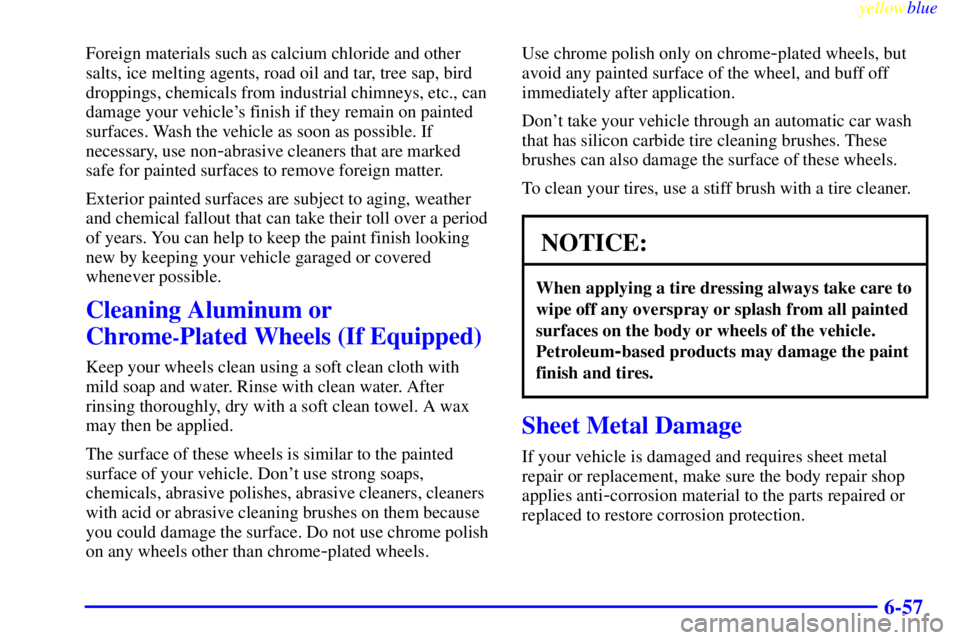
yellowblue
6-57
Foreign materials such as calcium chloride and other
salts, ice melting agents, road oil and tar, tree sap, bird
droppings, chemicals from industrial chimneys, etc., can
damage your vehicle's finish if they remain on painted
surfaces. Wash the vehicle as soon as possible. If
necessary, use non
-abrasive cleaners that are marked
safe for painted surfaces to remove foreign matter.
Exterior painted surfaces are subject to aging, weather
and chemical fallout that can take their toll over a period
of years. You can help to keep the paint finish looking
new by keeping your vehicle garaged or covered
whenever possible.
Cleaning Aluminum or
Chrome
-Plated Wheels (If Equipped)
Keep your wheels clean using a soft clean cloth with
mild soap and water. Rinse with clean water. After
rinsing thoroughly, dry with a soft clean towel. A wax
may then be applied.
The surface of these wheels is similar to the painted
surface of your vehicle. Don't use strong soaps,
chemicals, abrasive polishes, abrasive cleaners, cleaners
with acid or abrasive cleaning brushes on them because
you could damage the surface. Do not use chrome polish
on any wheels other than chrome
-plated wheels.Use chrome polish only on chrome
-plated wheels, but
avoid any painted surface of the wheel, and buff off
immediately after application.
Don't take your vehicle through an automatic car wash
that has silicon carbide tire cleaning brushes. These
brushes can also damage the surface of these wheels.
To clean your tires, use a stiff brush with a tire cleaner.
NOTICE:
When applying a tire dressing always take care to
wipe off any overspray or splash from all painted
surfaces on the body or wheels of the vehicle.
Petroleum
-based products may damage the paint
finish and tires.
Sheet Metal Damage
If your vehicle is damaged and requires sheet metal
repair or replacement, make sure the body repair shop
applies anti
-corrosion material to the parts repaired or
replaced to restore corrosion protection.
Page 309 of 392
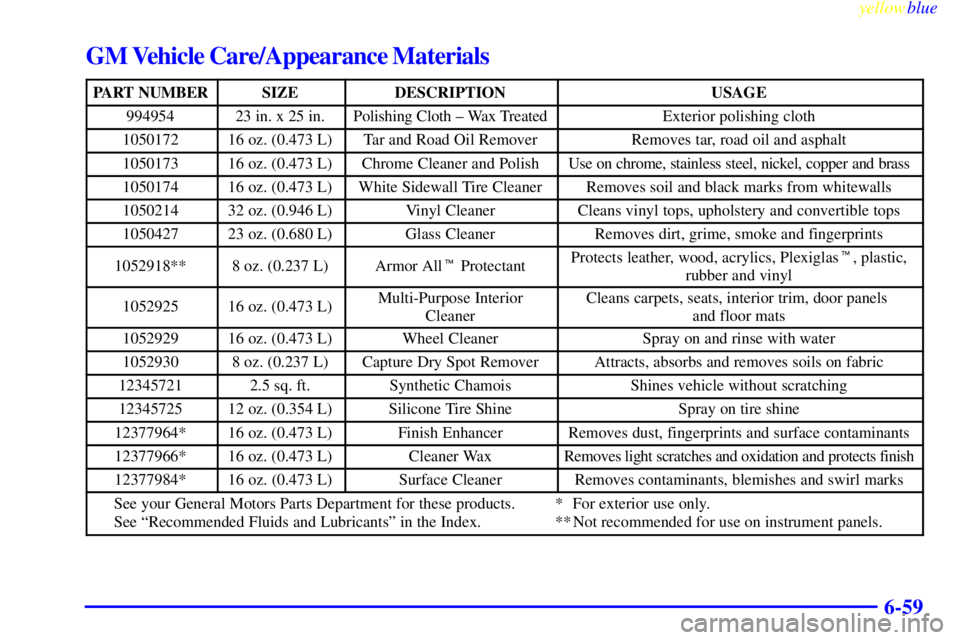
yellowblue
6-59
GM Vehicle Care/Appearance Materials
PART NUMBERSIZEDESCRIPTIONUSAGE
99495423 in. x 25 in.Polishing Cloth ± Wax TreatedExterior polishing cloth
105017216 oz. (0.473 L)Tar and Road Oil RemoverRemoves tar, road oil and asphalt
105017316 oz. (0.473 L)Chrome Cleaner and PolishUse on chrome, stainless steel, nickel, copper and brass
105017416 oz. (0.473 L)White Sidewall Tire CleanerRemoves soil and black marks from whitewalls
105021432 oz. (0.946 L)Vinyl CleanerCleans vinyl tops, upholstery and convertible tops
105042723 oz. (0.680 L)Glass CleanerRemoves dirt, grime, smoke and fingerprints
1052918**8 oz. (0.237 L)Armor All� ProtectantProtects leather, wood, acrylics, Plexiglas�, plastic,
rubber and vinyl
105292516 oz. (0.473 L)Multi-Purpose Interior
CleanerCleans carpets, seats, interior trim, door panels
and floor mats
105292916 oz. (0.473 L)Wheel CleanerSpray on and rinse with water
10529308 oz. (0.237 L)Capture Dry Spot RemoverAttracts, absorbs and removes soils on fabric
123457212.5 sq. ft.Synthetic ChamoisShines vehicle without scratching
1234572512 oz. (0.354 L)Silicone Tire ShineSpray on tire shine
12377964*16 oz. (0.473 L)Finish EnhancerRemoves dust, fingerprints and surface contaminants
12377966*16 oz. (0.473 L)Cleaner WaxRemoves light scratches and oxidation and protects finish
12377984*16 oz. (0.473 L)Surface CleanerRemoves contaminants, blemishes and swirl marks
See your General Motors Parts Department for these products. * For exterior use only.
See ªRecommended Fluids and Lubricantsº in the Index. ** Not recommended for use on instrument panels.
Page 313 of 392
yellowblue
6-63 Driver's Side Fuse Block
The driver's side fuse block is to the left of the steering
wheel, under the instrument panel.
Snap off the cover to reveal the fuses. You'll find a fuse
puller clipped to the inside of the cover. Place the wide
end of the fuse puller over the plastic end of the fuse.
Squeeze the ends over the fuse and pull it out.
Spare fuses are located in the slots labeled ªSpareº on
the following chart.
When finished, replace the cover by snapping it back up
into place.
Page 319 of 392
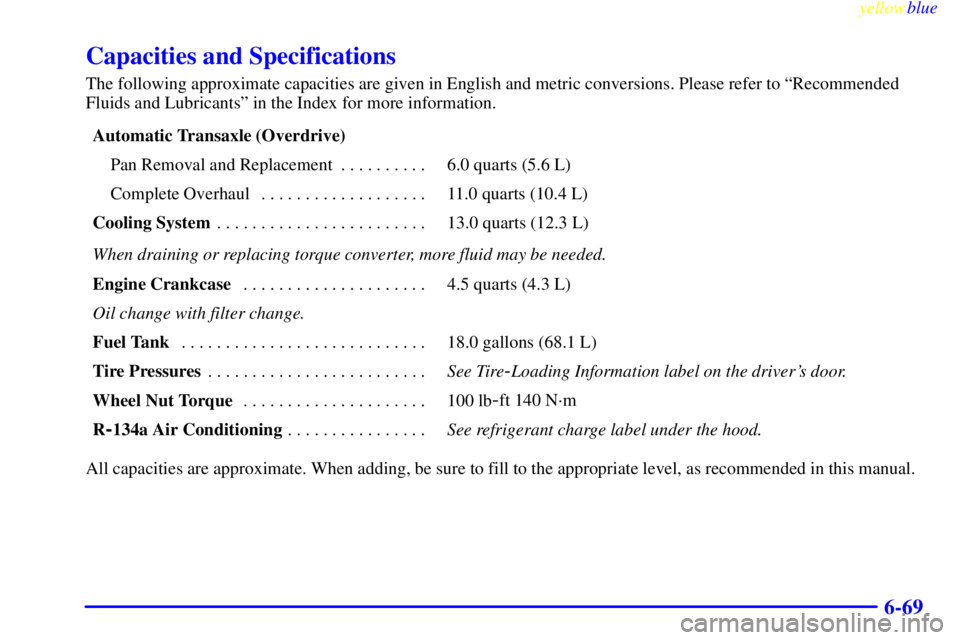
yellowblue
6-69
Capacities and Specifications
The following approximate capacities are given in English and metric conversions. Please refer to ªRecommended
Fluids and Lubricantsº in the Index for more information.
Automatic Transaxle (Overdrive)
Pan Removal and Replacement . . . . . . . . . . 6.0 quarts (5.6 L)
Complete Overhaul . . . . . . . . . . . . . . . . . . . 11.0 quarts (10.4 L)
Cooling System. . . . . . . . . . . . . . . . . . . . . . . . 13.0 quarts (12.3 L)
When draining or replacing torque converter, more fluid may be needed.
Engine Crankcase. . . . . . . . . . . . . . . . . . . . . 4.5 quarts (4.3 L)
Oil change with filter change.
Fuel Tank. . . . . . . . . . . . . . . . . . . . . . . . . . . . 18.0 gallons (68.1 L)
Tire Pressures. . . . . . . . . . . . . . . . . . . . . . . . . See Tire
-Loading Information label on the driver's door.
Wheel Nut Torque. . . . . . . . . . . . . . . . . . . . . 100 lb
-ft 140 N´m
R
-134a Air Conditioning. . . . . . . . . . . . . . . . See refrigerant charge label under the hood.
All capacities are approximate. When adding, be sure to fill to the appropriate level, as recommended in this manual.
Page 321 of 392
yellowblue
6-71 Vehicle Dimensions
Wheelbase 110.8 inches (281.4 cm). . . . . . . . . . . . . .
Tread Width . . . . . . . . . . . . . . . . . . . . . . . . . . . . . . . .
Front 60.4 inches (153.4 cm). . . . . . . . . . . . . . . . . .
Rear 60.3 inches (153.2 cm). . . . . . . . . . . . . . . . . . .
Length 201.9 inches (512.8 cm). . . . . . . . . . . . . . . . .
Width 74.6 inches (189.5 cm). . . . . . . . . . . . . . . . . . .
Height 55.7 inches (141.5 cm). . . . . . . . . . . . . . . . . . .
L36 Engine Accessory Belt
The L36 engine uses an engine accessory belt. This
diagram shows the features connected and the routing.
See ªMaintenance Scheduleº in the Index for when to
check the belt.
A. Power Steering
B. Generator
C. Air ConditioningD. Crank
E. Coolant Pump
F. Idler